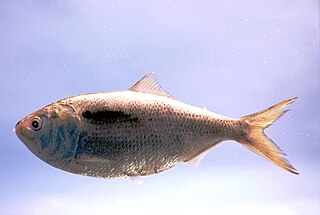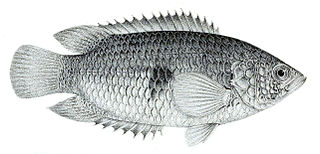
Menhaden, also known as mossbunker and bunker and "the most important fish in the sea", are forage fish of the genera Brevoortia and Ethmidium, two genera of marine fish in the order Clupeiformes. Menhaden is a blend of poghaden and an Algonquian word akin to Narragansett munnawhatteaûg, derived from munnohquohteau, referring to their use of the fish as fertilizer. It is generally thought that Pilgrims were advised by Tisquantum to plant menhaden with their crops.

Clupeiformes is the order of ray-finned fish that includes the herring family, Clupeidae, and the anchovy family, Engraulidae. The group includes many of the most important forage and food fish.

Clupeidae is a family of ray-finned fishes, comprising, for instance, the herrings and sardines. The clupeoids include many of the most important food fishes in the world, and are also commonly caught for production of fish oil and fish meal. Many members of the family have a body protected with shiny cycloid scales, a single dorsal fin, and a fusiform body for quick, evasive swimming and pursuit of prey composed of small planktonic animals. Due to their small size and position in the lower trophic level of many marine food webs, the levels of methylmercury they bioaccumulate are very low, reducing the risk of mercury poisoning when consumed.

Herring are forage fish, mostly belonging to the family of Clupeidae.

Geranium is a genus of 422 species of annual, biennial, and perennial plants that are commonly known as geraniums or cranesbills. They are found throughout the temperate regions of the world and the mountains of the tropics, with the greatest diversity in the eastern part of the Mediterranean region.

The spotted salamander or yellow-spotted salamander is a mole salamander common in eastern United States and Canada. It is the state amphibian of Ohio and South Carolina. The species ranges from Nova Scotia, to Lake Superior, to southern Georgia and Texas. Its embryos have been found to have symbiotic algae living in and around them, the only known example of vertebrate cells hosting an endosymbiont microbe.
The pelagic zone consists of the water column of the open ocean and can be further divided into regions by depth. The word pelagic is derived from Ancient Greek πέλαγος (pélagos) 'open sea'. The pelagic zone can be thought of as an imaginary cylinder or water column between the surface of the sea and the bottom. Conditions in the water column change with depth: pressure increases; temperature and light decrease; salinity, oxygen, micronutrients all change. Somewhat analogous to stratification in the Earth's atmosphere, but depending on how deep the water is, the water column can be divided vertically into up to five different layers.

Conium is a genus of flowering plants in the family Apiaceae. As of December 2020, Plants of the World Online accepts six species.

The Atlantic Spanish mackerel is a migratory species of mackerel that swims to the northern Gulf of Mexico in spring, returns to southern Florida in the eastern Gulf, and to Mexico in the western Gulf in the fall.

The Atlantic menhaden is a North American species of fish in the herring family, Clupeidae.

Aquarium fish feed is plant or animal material intended for consumption by pet fish kept in aquariums or ponds. Fish foods normally contain macronutrients, trace elements and vitamins necessary to keep captive fish in good health. Approximately 80% of fishkeeping hobbyists feed their fish exclusively prepared foods that most commonly are produced in flake, pellet or tablet form. Pelleted forms, some of which sink rapidly, are often used for larger fish or bottom feeding species such as loaches or catfish. Some fish foods also contain additives such as sex hormones or beta carotene to artificially enhance the color of ornamental fish.

Reedville is an unincorporated community in Northumberland County in the Northern Neck region of the U.S. state of Virginia. It is located at the eastern terminus of U.S. Route 360 east of Heathsville, at the head of Cockrell's Creek on the western shore of the Chesapeake Bay.
A fish factory, also called a fish plant, fish processing facility, is a facility where fish processing is performed. Fish factories range in the size and range of species of fish they process. Some species of fish, such as mackerel and herring, and can be caught at sea by large pelagic trawlers and offloaded to the factory within a few days of being caught. Or the fish can be caught by freezer trawlers that freeze the fish before providing it to factories, or by factory ships which can do the processing themselves on board. Some fish factories have fishing vessels catching fish for them at a given times of the year. This is to do with quotas and seasons conflicting how much and when the fish can be landed.
The spotted darter is a species of freshwater ray-finned fish, a darter from the subfamily Etheostomatinae, part of the family Percidae, which also contains the perches, ruffes and pikeperches. It is endemic to the eastern United States where it occurs in the basin of the Ohio River. It inhabits fast-flowing rocky riffles of medium-sized and smaller rivers. This species can reach a length of 9 centimetres (3.5 in) TL though most only reach about 5.5 centimetres (2.2 in).

Eutrochium maculatum, the spotted joe-pyeweed, is a North American species of flowering plant in the family Asteraceae. It is widespread through much of the United States and Canada. It is the only species of the genus Eutrochium found west of the Great Plains.

The Gulf menhaden is a small marine filter-feeding fish belonging to the family Clupeidae. The range of Gulf menhaden encompasses the entirety of the Gulf of Mexico nearshore waters, with the exception of the extreme eastern Yucatan and western Cuba. Evidence from morphology and DNA analyses suggest that the Gulf menhaden is the Gulf of Mexico complement to the Atlantic menhaden. Both species support large commercial reduction fisheries, with Gulf menhaden supporting the second largest fishery, by weight, in the United States.
Nothonotus microlepidum, the smallscale darter, is a species of freshwater ray-finned fish, a darter from the subfamily Etheostomatinae, part of the family Percidae, which also contains the perches, ruffes and pikeperches. It is endemic to the southeastern United States. It occurs in the lower Cumberland River drainage in the states of Kentucky and Tennessee. It inhabits shallow riffles with gravel substrates in small rivers. Breeding habits of the smallscale darter are typical of the E. maculatum group in that females deposit large masses of eggs on the undersides of rocks to be protected by the males. This species is a fairly large, deep-bodied fish with dark background coloration mixed with bright red spots scattered alongside the body. Nuptial males of this species also have deep green fins with orange margins on the spinous dorsal and caudal fins, with the soft dorsal fins having a dark coloration moving marginally to yellow-orangish center with black margins. This species can reach a length of 7.2 centimetres (2.8 in) TL though most only reach about 4.8 centimetres (1.9 in).

Ctenopoma maculatum is a fish in the family Anabantidae found in the coastal rivers from South Cameroon to the Democratic Republic of the Congo in the Chad, Ogoué, and Congo River basins. They grow to 20.0 cm in total length.

The Alosidae, or the shads, are a family of fishes. The family comprises seven genera worldwide, and about 30 species.















